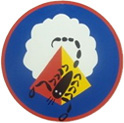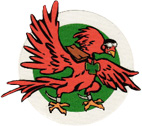|
 Anyway,
the story of how we got the Black Scorpion insignia
is an interesting one. The Group arrived in Palestine
with 65th insignia (Fighting Cock) and the 66th
Squadron insignia (Exterminator) established and
approved by whatever Board or Committee the Air
Corps had to authorize such considerations. Anyway,
the story of how we got the Black Scorpion insignia
is an interesting one. The Group arrived in Palestine
with 65th insignia (Fighting Cock) and the 66th
Squadron insignia (Exterminator) established and
approved by whatever Board or Committee the Air
Corps had to authorize such considerations.
The 64th Squadron submitted one that portrayed a
Knight in full armor, holding a jousting pole, and
on a warhorse going full tilt. Get the picture.
Anyway, this submission was denied approval and
the 64th had no insignia when it arrived in the
war zone.
Pudge Wheeler, who was the Squadron Commander, and
Buck Bilby who was Operations Officer decided to
do something about this matter. Both men had problems
with black scorpions getting in their shoes when
they set them under their cots. Several of our guys
got stung by them also. We all learned quickly to
tie our shoes to the ridgepole of our tents to keep
the pesky critters out of our shoes.
In any case, these two great guys suggested that
we adopt the black scorpion as our insignia. They
were agile. They had a stinger that poured out venom
and they could be deadly. The idea took hold and
we adopted the Black Scorpion as our insignia. Of
course, it was not authorized but we continued to
make additions and it evolved into the insignia
as you have seen it. We didn't add the pyramid until
we got into Sicily and Buck Bilby, Hal Routh and
I put the pyramid on to show where we had been.
It was also a symbol of strength. So we now have
a blue background of sky, a white cloud, a pyramid
with a fire-breathing black scorpion poised to sting
superimposed on it. Routh, who was the artist, decided
to put the red border around it. That is how it
came about.
Sometime in 1956, General Joe Cannon discovered
that this insignia had never been authorized, let
alone approved, and he took care of the necessary
formality to make everything legal. That is the
story.
—Paul Carll 64th
 From
“Stars and Stripes” Mediterranean Edition,
Rome, January 30. 1945: From
“Stars and Stripes” Mediterranean Edition,
Rome, January 30. 1945:
WITH THE 57TH FIGHTER GROUP – Uncle Bud II
came home today, the gift of Hal P. Monahan Sr.
of Lake Placid, NY, in memory of his son who was
killed fighting with the “Fighting Cocks”
In December 1943.
Like his predecessor Uncle Bud is cocky, ill-tempered,
fighting son-of-a-gun of a rooster and that’s
the way the boys like him.
When Col. Phil Cochran, former commander of the
“Fighting Cock” Squadron asked Milt
Caniff, creator of “Terry & The Pirates,”
to design the original Uncle Bud, he said, “I
don’t care what you come up with, Milt, just
so long as he’s a fighting son of a gun.”
Caniff chose the rooster, and Uncle Bud the First
came overseas with the squadron and followed it
from the hectic days of the North African campaign
until he was killed by a jeep last September. Lt.
Col. Gilbert O. Wymond of Detroit, the squadron’s
present commander, wrote to Caniff and asked him
to assist in finding a replacement.
Caniff passed the plea along to the readers of his
comic strip and from thousands of replies received,
he chose that of Monahan Sr., who asked that he
be allowed to sponsor the rooster in memory of his
son.
Republic Aviation Corp., who’s P-47’s
the “Fighting Cocks” fly in combat,
obtained the rooster and at a midafternoon ceremony
during the employees’ rest period, Monahan
presented the bird to Captains Ray Donahue, Jr.
of Pittsburgh, and James Eubanks of Bronte, Texas,
two members of the squadron home on 30 day leave.
The fliers smuggled Uncle Bud II on board ship by
hiding him under their coats. He shared their cabin
and got his first taste of army chow- C rations
and fruit, which the officers managed to scrounge.
Uncle Bud II has already proved himself a “Fighting
Cock.” His first official act upon being uncrated
was to rout a pet dog from the kitchen.
At the officers club, he was introduced to Uncle
Bud I, formerly believed by members of the squadron
to be the “meanest rooster alive”, mounted
in a fighting pose in a glass cage. The new arrival
immediately lashed out at the intruder with his
long spurs and had to be pulled away from the glass.
Said one pilot, “He’s even meaner than
Old Bud himself. He’ll do.”
 The
squadron insignia was designed by one of the enlisted
men, Howard Galipeau. A talented aircraft mechanic
as well as an artist of talent. It was originally
designed as a fighting duck in Windsor Locks in
1942 because it was thought the 57th would be going
to Alaska. When instead it was sent to Africa he
altered the design, which still resembled a penguin
or duck but very pugnacious. Early in the African
campaign a U.S. reporter visited the 57th and interviewed
the squadron and group personnel. The "Black
Scorpions" were the 64th, the "Fighting
Cocks" were the 65th but no name was assigned
to the 66th so he called it squadron "X".
So the X was added to the insignia. Due to the excellent
damage to the German forces in the desert war the
"X" was changed to "Exterminators"
which stuck to the squadron until the group was
declassified. The
squadron insignia was designed by one of the enlisted
men, Howard Galipeau. A talented aircraft mechanic
as well as an artist of talent. It was originally
designed as a fighting duck in Windsor Locks in
1942 because it was thought the 57th would be going
to Alaska. When instead it was sent to Africa he
altered the design, which still resembled a penguin
or duck but very pugnacious. Early in the African
campaign a U.S. reporter visited the 57th and interviewed
the squadron and group personnel. The "Black
Scorpions" were the 64th, the "Fighting
Cocks" were the 65th but no name was assigned
to the 66th so he called it squadron "X".
So the X was added to the insignia. Due to the excellent
damage to the German forces in the desert war the
"X" was changed to "Exterminators"
which stuck to the squadron until the group was
declassified.
Howard Galipeau passed away June 14th, 1999.
—Dave Hutton 66th
|